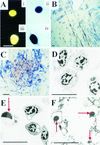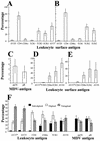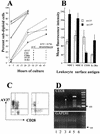Identification of the neoplastically transformed cells in Marek's disease herpesvirus-induced lymphomas: recognition by the monoclonal antibody AV37
- PMID: 12072527
- PMCID: PMC136297
- DOI: 10.1128/jvi.76.14.7276-7292.2002
Identification of the neoplastically transformed cells in Marek's disease herpesvirus-induced lymphomas: recognition by the monoclonal antibody AV37
Abstract
Understanding the interactions between herpesviruses and their host cells and also the interactions between neoplastically transformed cells and the host immune system is fundamental to understanding the mechanisms of herpesvirus oncology. However, this has been difficult as no animal models of herpesvirus-induced oncogenesis in the natural host exist in which neoplastically transformed cells are also definitively identified and may be studied in vivo. Marek's disease (MD) herpesvirus (MDV) of poultry, although a recognized natural oncogenic virus causing T-cell lymphomas, is no exception. In this work, we identify for the first time the neoplastically transformed cells in MD as the CD4(+) major histocompatibility complex (MHC) class I(hi), MHC class II(hi), interleukin-2 receptor alpha-chain-positive, CD28(lo/-), phosphoprotein 38-negative (pp38(-)), glycoprotein B-negative (gB(-)), alphabeta T-cell-receptor-positive (TCR(+)) cells which uniquely overexpress a novel host-encoded extracellular antigen that is also expressed by MDV-transformed cell lines and recognized by the monoclonal antibody (MAb) AV37. Normal uninfected leukocytes and MD lymphoma cells were isolated directly ex vivo and examined by flow cytometry with MAb recognizing AV37, known leukocyte antigens, and MDV antigens pp38 and gB. CD28 mRNA was examined by PCR. Cell cycle distribution and in vitro survival were compared for each lymphoma cell population. We demonstrate for the first time that the antigen recognized by AV37 is expressed at very low levels by small minorities of uninfected leukocytes, whereas particular MD lymphoma cells uniquely express extremely high levels of the AV37 antigen; the AV37(hi) MD lymphoma cells fulfill the accepted criteria for neoplastic transformation in vivo (protection from cell death despite hyperproliferation, presence in all MD lymphomas, and not supportive of MDV production); the lymphoma environment is essential for AV37(+) MD lymphoma cell survival; pp38 is an antigen expressed during MDV-productive infection and is not expressed by neoplastically transformed cells in vivo; AV37(+) MD lymphoma cells have the putative immune evasion mechanism of CD28 down-regulation; AV37(hi) peripheral blood leukocytes appear early after MDV infection in both MD-resistant and -susceptible chickens; and analysis of TCR variable beta chain gene family expression suggests that MD lymphomas have polyclonal origins. Identification of the neoplastically transformed cells in MD facilitates a detailed understanding of MD pathogenesis and also improves the utility of MD as a general model for herpesvirus oncology.
Figures







References
-
- Abujoub, A. A., and P. M. Coussens. 1997. Evidence that Marek's disease virus exists in a latent state in a sustainable fibroblast cell line. Virology 229:309-321. - PubMed
-
- Appleman, L. J., D. Tzachanis, T. Grader-Beck, A. van Puijenbroek, and V. A. Boussiotis. 2001. Helper T cell anergy: from biochemistry to cancer pathophysiology and therapeutics. J. Mol. Med. 78:673-683. - PubMed
-
- Arstila, T. P., P. Toivanen, O. Vainio, and O. Lassila. 1994. Gamma-delta and alpha-beta T-cells are equally susceptible to apoptosis. Scand. J. Immunol. 40:209-215. - PubMed
-
- Bacon, L. D. 1987. Influence of the major histocompatibility complex on disease resistance and productivity. Poult. Sci. 66:802-811. - PubMed
-
- Baigent, S. J., R. C. Bethell, and J. W. McCauley. 1999. Genetic analysis reveals that both haemagglutinin and neuraminidase determine the sensitivity of naturally occurring avian influenza viruses to zanamivir in vitro. Virology 263:323-338. - PubMed
MeSH terms
Substances
LinkOut - more resources
Full Text Sources
Medical
Research Materials

